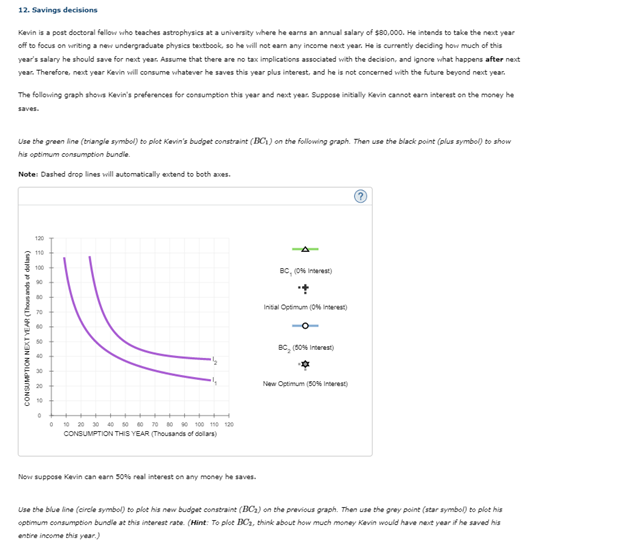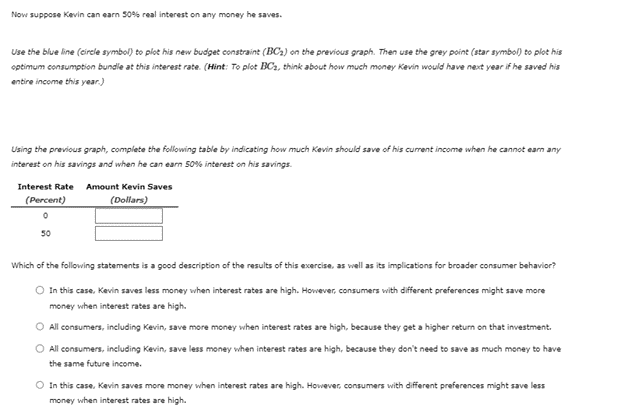12. Savings decisions Kevin is a postdoctoral fellow who teaches astrophysics at a university where he earns an annual salary of $80,000. He intends to take the next year off to focus on writing a new undergraduate physics textbook, so he will not earn any income next year. He is currently deciding how much of this year's salary he should save for next year. Assume that there are no tax implications associated with the decision, and ignore what happens after next year. Therefore, next year Kevin will consume whatever he saves this year plus interest, and he is not concerned with the future beyond next year. The following graph shows Kevin's preferences for consumption this year and next year. Suppose initially Kevin cannot earn interest on the money he saves. Use the green line (triangle symbol) to plot Kevin's budget constraint (BC) on the following graph. Then use the black point (plus symbol) to show his optimum consumption bundle. Note: Dashed drop lines will automatically extend to both axes. CONSUMPTION NEXT YEAR (Thousands of dollars) 110 28 20 0 10 20 30 40 50 60 70 80 90 100 110 120 CONSUMPTION THIS YEAR (Thousands of dollars) Now suppose Kevin can earn 50% real interest on any money he saves. BC, (0% Interest) Initial Optimum (0% Interest) BC, (50% Interest) New Optimum (50% Interest) Use the blue line (circle symbol) to plot his new budget constraint (BC₂) on the previous graph. Then use the grey point (star symbol) to plot his optimum consumption bundle at this interest rate. (Hint: To plot BC₂, think about how much money Kevin would have next year if he saved his entire income this year.)
12. Savings decisions Kevin is a postdoctoral fellow who teaches astrophysics at a university where he earns an annual salary of $80,000. He intends to take the next year off to focus on writing a new undergraduate physics textbook, so he will not earn any income next year. He is currently deciding how much of this year's salary he should save for next year. Assume that there are no tax implications associated with the decision, and ignore what happens after next year. Therefore, next year Kevin will consume whatever he saves this year plus interest, and he is not concerned with the future beyond next year. The following graph shows Kevin's preferences for consumption this year and next year. Suppose initially Kevin cannot earn interest on the money he saves. Use the green line (triangle symbol) to plot Kevin's budget constraint (BC) on the following graph. Then use the black point (plus symbol) to show his optimum consumption bundle. Note: Dashed drop lines will automatically extend to both axes. CONSUMPTION NEXT YEAR (Thousands of dollars) 110 28 20 0 10 20 30 40 50 60 70 80 90 100 110 120 CONSUMPTION THIS YEAR (Thousands of dollars) Now suppose Kevin can earn 50% real interest on any money he saves. BC, (0% Interest) Initial Optimum (0% Interest) BC, (50% Interest) New Optimum (50% Interest) Use the blue line (circle symbol) to plot his new budget constraint (BC₂) on the previous graph. Then use the grey point (star symbol) to plot his optimum consumption bundle at this interest rate. (Hint: To plot BC₂, think about how much money Kevin would have next year if he saved his entire income this year.)
Chapter17: Capital And Time
Section: Chapter Questions
Problem 17.7P
Related questions
Question

Transcribed Image Text:12. Savings decisions
Kevin is a postdoctoral fellow who teaches astrophysics at a university where he earns an annual salary of $80,000. He intends to take the next year
off to focus on writing a new undergraduate physics textbook, so he will not earn any income next year. He is currently deciding how much of this
year's salary he should save for next year. Assume that there are no tax implications associated with the decision, and ignore what happens after next
year. Therefore, next year Kevin will consume whatever he saves this year plus interest, and he is not concerned with the future beyond next year.
The following graph shows Kevin's preferences for consumption this year and next year. Suppose initially Kevin cannot earn interest on the money he
saves.
Use the green line (triangle symbol) to plot Kevin's budget constraint (BC) on the following graph. Then use the black point (plus symbol) to show
his optimum consumption bundle.
Note: Dashed drop lines will automatically extend to both axes.
CONSUMPTION NEXT YEAR (Thousands of dollars)
28 20
0 10 20 30 40 50 60 70 80 90 100 110 120
CONSUMPTION THIS YEAR (Thousands of dollars)
Now suppose Kevin can earn 50% real interest on any money he saves.
BC, (0% Interest)
Initial Optimum (0% Interest)
BC, (50% Interest)
New Optimum (50% Interest)
Use the blue line (circle symbol) to plot his new budget constraint (BC₂) on the previous graph. Then use the grey point (star symbol) toplot his
optimum consumption bundle at this interest rate. (Hint: To plot BC₂, think about how much money Kevin would have next year if he saved his
entire income this year.)

Transcribed Image Text:Now suppose Kevin can earn 50% real interest on any money he saves.
Use the blue line (circle symbol) to plot his new budget constraint (BC₂) on the previous graph. Then use the grey point (star symbol) to plot his
optimum consumption bundle at this interest rate. (Hint: To plot BC₂, think about how much money Kevin would have next year if he saved his
entire income this year.)
Using the previous graph, complete the following table by indicating how much Kevin should save of his current income when he cannot earn any
interest on his savings and when he can earn 50% interest on his savings.
Interest Rate Amount Kevin Saves
(Dollars)
(Percent)
0
Which of the following statements is a good description of the results of this exercise, as well as its implications for broader consumer behavior?
In this case, Kevin saves less money when interest rates are high. However, consumers with different preferences might save more
money when interest rates are high.
All consumers, including Kevin, save more money when interest rates are high, because they get a higher return on that investment.
All consumers, including Kevin, save less money when interest rates are high, because they don't need to save as much money to have
the same future income.
In this case, Kevin saves more money when interest rates are high. However consumers with different preferences might save less
money when interest rates are high.
Expert Solution
This question has been solved!
Explore an expertly crafted, step-by-step solution for a thorough understanding of key concepts.
This is a popular solution!
Trending now
This is a popular solution!
Step by step
Solved in 5 steps with 2 images

Knowledge Booster
Learn more about
Need a deep-dive on the concept behind this application? Look no further. Learn more about this topic, economics and related others by exploring similar questions and additional content below.Recommended textbooks for you


Principles of Microeconomics
Economics
ISBN:
9781305156050
Author:
N. Gregory Mankiw
Publisher:
Cengage Learning

Microeconomics: Private and Public Choice (MindTa…
Economics
ISBN:
9781305506893
Author:
James D. Gwartney, Richard L. Stroup, Russell S. Sobel, David A. Macpherson
Publisher:
Cengage Learning


Principles of Microeconomics
Economics
ISBN:
9781305156050
Author:
N. Gregory Mankiw
Publisher:
Cengage Learning

Microeconomics: Private and Public Choice (MindTa…
Economics
ISBN:
9781305506893
Author:
James D. Gwartney, Richard L. Stroup, Russell S. Sobel, David A. Macpherson
Publisher:
Cengage Learning

Economics: Private and Public Choice (MindTap Cou…
Economics
ISBN:
9781305506725
Author:
James D. Gwartney, Richard L. Stroup, Russell S. Sobel, David A. Macpherson
Publisher:
Cengage Learning

Principles of Economics 2e
Economics
ISBN:
9781947172364
Author:
Steven A. Greenlaw; David Shapiro
Publisher:
OpenStax
